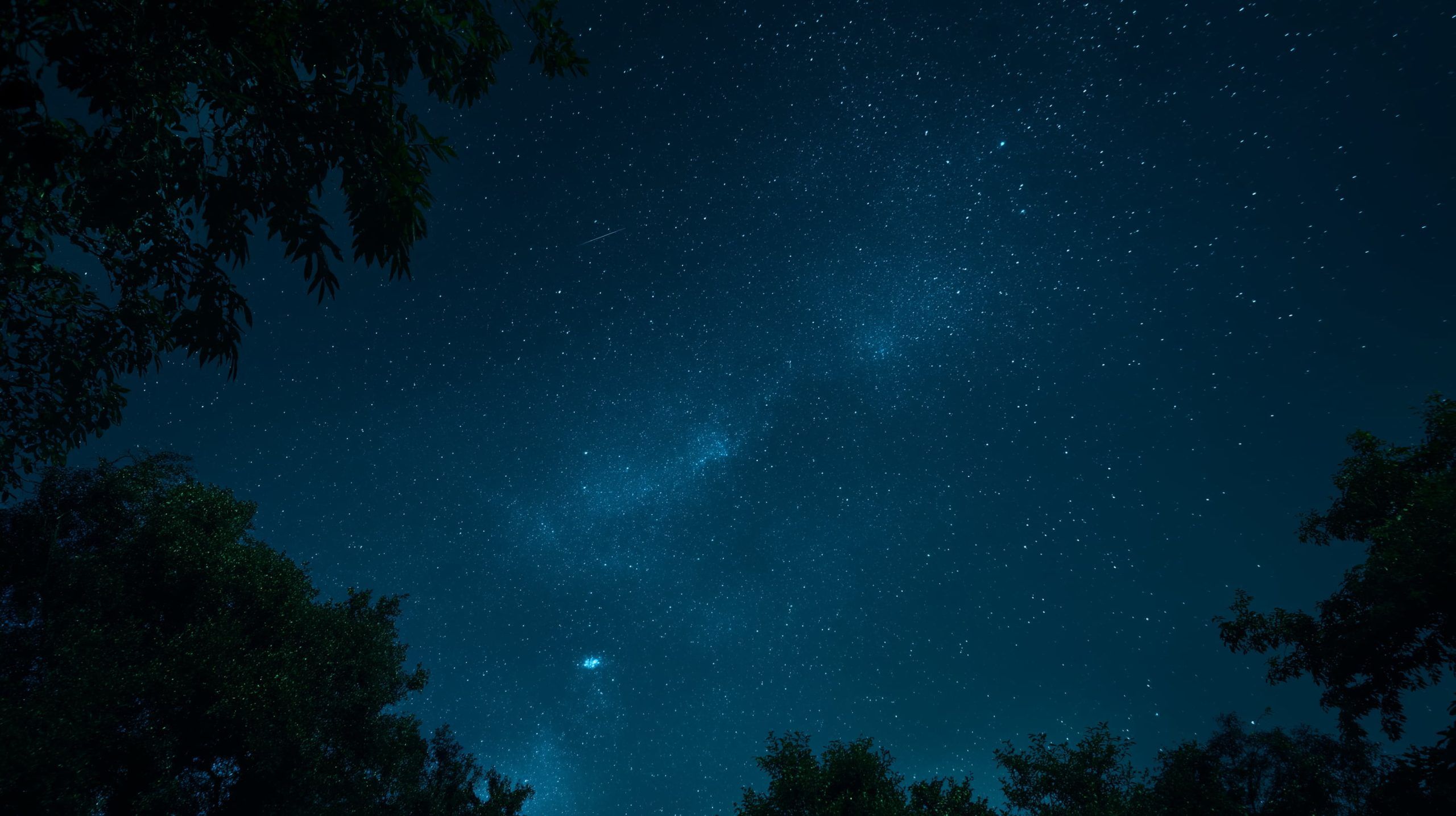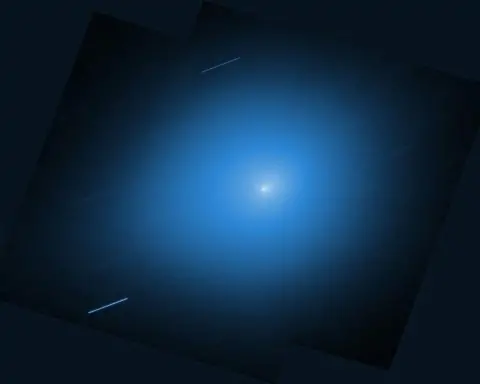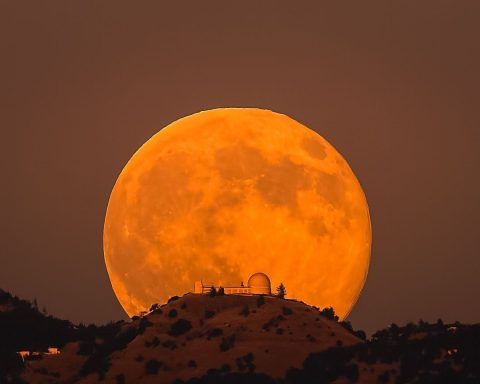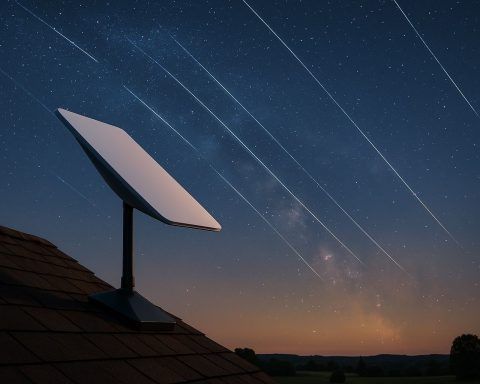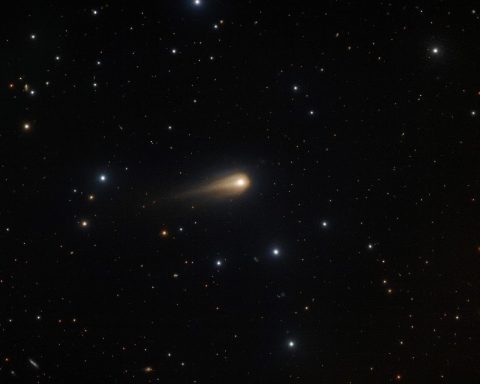- Brilliant Harvest Supermoon: A supermoon rises on the night of October 5–6, appearing about 14% larger and 30% brighter than a typical full moon [1]. It’s the year’s Harvest Moon – the first full moon of autumn – shining big and bright and even helping farmers squeeze in extra harvest time at dusk [2] [3].
- Draconid “Dragon” Meteors: The annual Draconid meteor shower is active October 6–10, peaking around Oct. 8 with up to ~10 slow-moving meteors per hour under ideal dark skies [4]. However, the glare of the supermoon will wash out many of these “shooting stars” [5] – so only a few of the brightest meteors may be visible each night.
- Aurora Alert Fading: After a week of intense aurora borealis activity (a surprise G3 geomagnetic storm lit up skies as far south as New York on Oct. 1 [6]), geomagnetic storm levels are now easing. A minor G1 storm watch remains in effect, meaning auroras could still flicker on the northern horizon at high latitudes through Oct. 5 [7]. The Northern Lights are mostly expected in polar regions as the solar wind stream calms.
- Moon Meets Saturn: On Oct. 5–6 evenings, look east after sunset to spot the nearly full Moon gliding right beside Saturn. The bright Moon and ringed planet rise together at dusk and travel side by side across the night sky [8]. This striking Moon-Saturn pairing is visible worldwide (for example, all night in North America and Europe [9]), offering an easy target even in city skies.
- Planets on the Move:Jupiter is also on display, rising in the east by late evening and shining brilliantly through the night (it will reach opposition in a few weeks). In the pre-dawn hours, Venus gleams as the “morning star” low in the east [10] – an eye-catching sight for early risers. (By contrast, Mars and Mercury are lurking near the Sun and not easily visible from mid-northern latitudes at this time.)
- New Comets Brightening: Astronomers are tracking two new comets making close approaches this month. Comet C/2025 A6 (Lemmon) will swing within ~89 million km of Earth on Oct. 21 and is steadily brightening from binocular range (magnitude ~7) toward possible naked-eye visibility later in October [11]. Comet C/2025 R2 (SWAN) is also set to reach peak brightness in late October. Both icy visitors will coincide with the Orionid meteor shower’s peak around Oct. 21–22, benefitting from moonless dark skies [12]. Experts say Comet Lemmon could even reach magnitude 4 or brighter by month’s end (though comets are notoriously unpredictable) [13].
- Unusual Satellite Sightings: Don’t be alarmed if you catch a strange train of lights or a slow-burning fireball in the sky. SpaceX’s Starlink satellites often produce “satellite trains” shortly after launch – bright strings of moving dots. And with over 8,000 Starlink satellites in orbit as of late 2025 [14], about 1–2 are falling back to Earth every day [15] [16]. In fact, on Sept. 25 skywatchers in California witnessed a Starlink satellite reenter the atmosphere as a spectacular, slow-moving fireball breaking apart [17]. Such reentry streaks last much longer than a typical meteor [18]. While these events pose no risk (the hardware burns up), they are a reminder of our crowded skies.
The Night Sky Spectacle: October 5–6, 2025
As we head into the first weekend of October 2025, the night sky is bursting with activity. From an extra-bright full Moon to a flurry of meteors – and even lingering auroras and newfound comets – skywatchers across the globe have plenty to look up for. Here’s a detailed rundown of what to expect on the nights of October 5–6, 2025, including where and when to see each phenomenon, expert insights, and viewing tips from NASA, NOAA, and other authorities.
A Dazzling Harvest Supermoon Takes Center Stage
The Moon will be the undeniable star of the show this weekend. On the night of Oct. 5–6, it reaches full phase and also swings very close to Earth in its orbit – making it a “supermoon.” In fact, this full Moon (traditionally called the Harvest Moon for being nearest to the autumn equinox) will be exceptionally large and luminous. NASA notes that a supermoon like this can appear up to 14% bigger in diameter and about 30% brighter than a typical full moon [19]. The Moon’s distance at full phase will be around 361,000 km from Earth, roughly 10% closer than average [20], which accounts for its extra brilliance.
Expect the Moon to rise around sunset on Oct. 5 and beam all night long, setting near sunrise. For the best experience, astronomers recommend catching the Moon at moonrise on the eastern horizon – just after sunset – when it looms large and golden. “The moon’s golden-orange glow will be most striking during the 15–20 minutes after local moonrise wherever you are,” advises one sky observer [21]. No special equipment is needed to enjoy it (your eyes are enough), though binoculars can reveal lunar craters and maria (the dark lava plains) in lovely detail [22].
Because this is the Harvest Moon, it carries some cultural lore too. Normally, full moons rise about 50 minutes later each night, but near the fall equinox that gap shortens to only ~20–30 minutes. This means for several evenings in a row the nearly full Moon hangs in the early-night sky, providing farmers with extra light to gather crops – hence the name “Harvest Moon” [23]. (This year the Harvest Moon falls in October, rather than September, due to the lunar cycle’s timing [24].) Around the world, various harvest festivals coincide with this moon: for example, the Korean Chuseok and the Chinese/Vietnamese Mid-Autumn Festival traditionally celebrate the bright full moon and the bounty of the season [25].
Skywatching tip: The full Moon’s brilliance is beautiful but will flood the sky with light. If you’re also trying to spot faint objects like meteors or comets (more on those below), you might position yourself so that a building, hill, or even your hand can block the Moon from your direct view [26]. This can help your eyes adapt to darkness a bit better. Remember, unlike the Sun, it’s perfectly safe to gaze at the Moon – you won’t harm your eyes. At most, a supermoon might feel almost too bright when you’re fully dark-adapted, but it cannot cause injury (though peering at it through a telescope without a filter might be uncomfortable due to the glare).
Draconid Meteor Shower: Dragons vs. Moonlight
The early October full moon might outshine most stars, but meteors will still attempt to pierce through. This week marks the peak of the Draconid meteor shower, a minor annual shower active roughly October 6–10 each year [27]. The Draconids are often called the “dragon” meteors because they appear to emanate from the head of the constellation Draco the Dragon, in the northern sky.
When and where to watch: In 2025, the Draconids are predicted to reach maximum activity on the evening of October 8 (around 19:00–20:00 UTC) [28]. However, noticeable meteor activity is possible on the nights of Oct. 6, 7, and 8 all through the first week of October. Uniquely, the Draconids are best observed in the evening hours, right after nightfall, rather than after midnight. That’s because Draco’s “head” – the radiant point – stands highest in the sky in the early evenings at this time of year [29] [30]. So unlike most meteor showers that strengthen late at night, the Draconid meteors tend to fly during the evening and taper off by late night.
Viewers in the Northern Hemisphere are favored (Draco is a northern constellation). If you’re in mid-northern latitudes, try looking toward the northwest sky after twilight – find the Big Dipper low on the horizon and trace up toward Draco twisting between Ursa Major and Ursa Minor. From southern latitudes, Draco is lower or below the horizon, so the Draconids are not well-seen in places like Australia or South Africa.
What to expect: The Draconids are usually a relatively quiet shower, with a handful of slow meteors per hour. Under a perfectly dark sky with no Moon, observers might catch around 5–10 meteors per hour at the peak [31]. This year, however, the bright waning gibbous Moon (just past full) will be lighting up the sky, which will drown out the fainter meteors [32]. Even NASA quips that if you don’t see many Draconids, “you can always blame the bright supermoon” for outshining them [33]. Realistically, you may only glimpse the brightest few “shooting stars” – perhaps a couple per hour – radiating from Draco.
That said, the Draconids have a wild card reputation. This shower originates from debris of Comet 21P/Giacobini–Zinner, and most years it’s a dud except when Earth crosses especially dense clumps of debris. On rare occasions, the Dragon awakens: historic outbursts in 1933 and 1946 produced hundreds or even thousands of meteors per hour, and more recently a burst of ~600 per hour was observed in 2011 over Europe [34] [35]. Those occurred when the parent comet had recently passed perihelion (its closest point to the Sun). Notably, Comet Giacobini–Zinner did reach perihelion in March 2025 [36], raising some speculation that 2025 could produce enhanced Draconid activity. While no meteor “storm” is specifically forecast, and the moonlight would interfere regardless, it’s still worth a look – there’s always a slim chance of catching an unexpected flurry of brighter meteors if the comet’s debris trail is particularly rich this year [37].
Viewing tips: To watch for Draconids, pick a viewing spot away from city lights (the darker, the better) and give your eyes ~20 minutes to adjust. Face generally north/northwest and scan the sky – meteors can appear anywhere overhead, though their paths will trace back to Draco’s radiant. As mentioned, try to keep the Moon out of your direct field of view (perhaps stand in a shadow or use a brimmed hat) so that your eyes can stay as dark-adapted as possible [38]. A reclining lawn chair or blanket can make meteor-watching more comfortable. And bundle up – October nights can be chilly!
If you don’t catch many “dragon” meteors, don’t be discouraged – a more reliable meteor shower is on the way later in the month, when moonlight won’t be a problem.
Orionids Ahead: Halley’s Comet Sparks a Late-October Shower
Mark your calendars: the Orionid meteor shower – one of the year’s more prominent showers – will peak on October 21–22. The Orionids are already active throughout October (from about Sept. 26 to Nov. 22) [39], meaning you might spot an occasional Orionid meteor on any clear night this week. These meteors are famous for originating from Halley’s Comet: every fall, Earth passes through the dust trail of Halley’s Comet, and bits of that debris burn up as the Orionid “shooting stars” streaking from the constellation Orion [40].
During the Oct. 21 peak, the Orionids can produce around 20 meteors per hour under ideal conditions [41]. Fortunately, this year the Moon will be near New Moon (just a thin crescent) during the Orionid peak, so dark skies are expected – great news for meteor watchers. The best time to observe Orionids is usually after midnight until dawn (when Orion has risen high in the sky). NASA suggests trying just before midnight into the early hours for the peak night [42] – roughly 11 PM to 2 AM – for a good window of activity. Orionid meteors are typically swift and occasionally leave persistent trains of ionized gas glowing in their wake.
While the Orionid peak is still a couple of weeks after Oct 5–6, you might see a few early Orionids now, especially late at night toward dawn. If you spot a fast meteor in the east or south part of the sky in the pre-dawn hours, there’s a chance it could be an Orionid starting to make its appearance. Any Orionids at this stage will be very infrequent, though – single digits per hour at best.
The real excitement is that this year’s Orionid peak coincides with something special: two comets in the sky (more on those next). With new moon darkness and possibly comet sightings, the night of Oct. 21–22 could be a bonanza for sky enthusiasts [43]. But until then, we have plenty to see this week!
Fading Aurora Borealis After Geomagnetic Storms
If you live in far-northern latitudes (Canada, Northern Europe, etc.), you may have been treated to a spectacular aurora borealis show in recent days. Earlier this week, the Sun’s activity sent waves of charged particles our way, sparking geomagnetic storms that lit up the skies with auroras dancing surprisingly far south. In fact, on the night of Oct. 1–2 a strong G3 geomagnetic storm was observed, and vibrant Northern Lights were sighted as far south as New York and Wisconsin in the U.S. [44], and across parts of central Europe, amid that unexpected solar storm burst.
Now, as we enter Oct. 5–6, those displays are winding down. EarthSky’s solar weather update on Oct. 4 noted that after about five days of heightened activity, the geomagnetic storm was “finally starting to ease” [45]. The culprit was a high-speed stream of solar wind from a coronal hole on the Sun, which is now calming. Solar wind speeds dropped from a fierce ~768 km/s on Oct. 3 down to ~600 km/s by Oct. 4, meaning the geomagnetic unrest is diminishing [46].
The U.S. NOAA Space Weather Prediction Center had issued a G1 (minor) geomagnetic storm watch through this weekend, indicating that auroras could still appear at high latitudes (especially overnight Oct. 4 into Oct. 5) under minor storm conditions [47]. In practical terms, this means areas like northern Canada, Alaska, Scandinavia, Iceland, and maybe the northernmost continental U.S. (on the horizon) might glimpse some modest auroral glows if the skies are clear and dark. By Oct. 5–6, geomagnetic activity is expected to settle back to quieter levels as the solar wind stream wanes [48]. So any auroras will likely be confined to the usual polar zones or will be much fainter than earlier in the week.
However, the Sun isn’t done tossing surprises. Space weather forecasters observed a small coronal mass ejection (CME) from an M1.5-class solar flare on Oct. 3, which models suggest could reach Earth around October 8 [49]. If that timing holds, we might see another brief uptick in auroral activity mid-week (Oct. 7–8). It would likely be a minor disturbance, but aurora chasers should stay tuned to space weather alerts in case another G1–G2 level storm materializes. As always, the aurora forecast can change quickly based on solar activity. For now, though, Oct. 5–6 should be relatively quiet for Northern Lights.
If you are in a location prone to auroras (e.g. northern Scotland, Canada, Alaska), it’s still worth a quick look to the north on these nights – maybe a faint green glow or subtle pulsations will be on the horizon. And if not, you can at least enjoy the moonlit landscape. For real-time aurora forecasts, you can check NOAA’s aurora dashboard or your country’s space weather service. NOAA’s 3-day outlook is updated regularly and indicated Kp index ~4–5 (minor storm) conditions tapering off by October 5 [50] [51].
Expert tip: If an aurora is expected, dark-adapt your vision and avoid city lights. Auroras can be faint; a camera (with a high ISO setting and long exposure) might catch color that your eyes can’t. And note that auroras can surge or fade unpredictably – patience is key.
Lastly, remember that increased aurora activity is a side effect of the Sun’s 11-year cycle ramping up. We’re approaching the next solar maximum (around 2025–2026), so geomagnetic storm alerts may become more common. Always use reputable sources (NOAA, Space Weather Prediction Center, etc.) for aurora alerts, and beware of exaggerated social media rumors. In this case, the “alert” is simply to enjoy any lingering auroras now that the big show has quieted down.
Moon Meets Saturn: A Planetary Conjunction
One treat that will be easy to spot on Oct. 5–6 is the lovely pairing of the Moon and Saturn. As mentioned, on these nights the nearly full Moon will be in the same part of the sky as Saturn, leading to a striking conjunction. On Oct. 5 evening, with your back to the sunset, look east: you’ll see a brilliant moonrise, and right nearby (a few degrees to one side) will be a golden point of light – that’s Saturn. They rise together as the sky gets dark and will remain visible as a close pair all night [52].
From North America and Europe, the Moon and Saturn will appear side by side through the night, separated by only ~3–5° (close enough to share a view in binoculars). In New York or London, for example, they climb above the horizon at dusk and arc across the southern sky until dawn [53]. In the Southern Hemisphere (e.g. Sydney), the timing is a bit shifted – the Moon and Saturn rise later at night and are closest together toward early morning (just before sunrise) on Oct. 6 [54], low in the west. But the general effect is similar worldwide.
Saturn itself is a wonderful object right now. The ringed planet reached opposition (its yearly closest approach to Earth) a few weeks ago, so it’s still near peak brightness and about as large as it gets in telescopes [55]. Even a small telescope will show Saturn’s iconic rings and maybe a moon or two (Titan, its largest moon, looks like a star nearby). With the full Moon so close, telescope viewing is a bit tougher due to glare, but it’s still worth a try if you have one – just wait until the Moon and Saturn are higher up to minimize atmospheric turbulence.
For the naked-eye observer, Saturn will look like a moderately bright, yellowish “star” next to the dazzling Moon. It doesn’t twinkle much, which is one hint it’s a planet. Over the course of the night, you can actually notice the Moon’s motion relative to Saturn – the Moon moves its own diameter roughly every hour. By the next night (Oct. 6–7), the Moon will have moved on, and Saturn will stand alone again.
This Moon-Saturn conjunction poses no special risk – unlike a solar eclipse or anything, you can freely enjoy it without precautions. It’s just a neat celestial meetup. Feel free to point it out to friends or family: “that bright star by the Moon is Saturn, ~1.4 billion km away!” It’s a great conversation starter about astronomy.
Other Planets Visible
Jupiter – the king of planets – is also making its presence known. Jupiter rises later in the evening on Oct. 5–6 (roughly by 10–11 PM local time in mid-northern latitudes, a bit earlier further east). By midnight, Jupiter will be shining high in the east-southeast. It’s extremely bright (outshone only by the Moon and Venus in the night sky), with a gleaming white-yellow hue. Through binoculars or a small scope you might spot Jupiter’s four big moons lined up. Jupiter is on approach to its own opposition in late November 2025, so it’s getting brighter each week.
Venus, meanwhile, has transitioned into the morning sky. After spending mid-2025 hidden near the Sun, Venus now rises before dawn and is currently the brilliant “Morning Star” in the east. By Oct. 5–6, around 5–6 AM local time, Venus will blaze over the eastern horizon – you can’t miss its silver-white glow if you’re up early. In fact, Venus is so bright that some have seen it in broad daylight when they know exactly where to look. Timeanddate notes that around October 19, a slim crescent Moon will join Venus at dawn for a pretty conjunction [56]. But even on Oct. 5–6, Venus by itself is a gorgeous sight against the dawn colors. (Fun fact: Venus is currently further from the Sun from our viewpoint, which is why it’s prominent in the morning – hence the nickname “Morning Star” [57].)
Mars and Mercury are the two planets you likely won’t see on these dates. Mars is still very close to the Sun from our perspective (having passed solar conjunction a few months ago). It’s faint and buried in the Sun’s glare, so we have to wait a bit longer for Mars to emerge in the evening sky later this year. Mercury, similarly, is just beginning an evening apparition but is best viewed from the Southern Hemisphere later in October. (In fact, on Oct. 23, a crescent Moon, Mercury, and Mars will form a little triangle low on the sunset horizon as seen from Australia/New Zealand [58] [59] – but that will be a treat for southern stargazers in a few weeks, not relevant for Oct. 5–6 and not visible for most northerners.)
So to summarize: on Oct. 5–6 night, Moon+Saturn dominate early evening; Jupiter rules late night; and Venus greets the dawn. It’s a good spread! If you have clear skies, it’s worth scanning around: you might catch Saturn’s steady glow, Jupiter’s brilliance, Venus’s beacon, and maybe even the dimmer outer planets (Uranus and Neptune require binoculars or a telescope, but both are actually up at night too – Neptune in the early evening in Aquarius, Uranus in the late night in Aries).
Comets: Two Icy Visitors Grace October Skies
In addition to the regular planets, two comets are creating buzz among the astronomy community this month – and they add an extra excitement to October skywatching. While these comets are not yet spectacular to the naked eye, they might become visible in binoculars (or even without aid, if we’re lucky) later in the month. Here’s the scoop:
- Comet C/2025 A6 (Lemmon): Discovered in January 2025 at Arizona’s Mount Lemmon Observatory, this comet has been approaching and brightening all year [60]. It will make its closest approach to Earth on Oct. 21, 2025 (at about 89 million km distance) [61]. Currently, in early October, Comet Lemmon is about magnitude 7–8 – just a fuzzy smudge in binoculars or telescopes [62] [63]. It’s moving through the northern sky (near the Big Dipper in Ursa Major in early October) [64] [65]. The exciting part is that after mid-October, Comet Lemmon is expected to brighten rapidly as it heads toward perihelion (closest point to the Sun on Nov. 8) [66]. By late October, some forecasts suggest it could reach around magnitude 4, or even 3 at peak [67]. In other words, it might become faintly visible to the naked eye under dark skies – potentially the brightest comet of 2025 [68]. EarthSky reports that estimates of its brightness range “from magnitude 4 to 2.5” around end of October, though of course comets are unpredictable [69]. If you have a telescope or good binoculars, you could try hunting for Comet Lemmon now. It appears as a diffuse, pale glow with a developing tail. By Oct. 5–6 it’s still fairly dim (around mag 7) [70] and best seen in the early morning hours before dawn, low in the northeast (for Northern Hemisphere observers) [71]. As the month progresses it will shift into the evening sky and climb higher. Around Orionid meteor shower peak (Oct. 21–22) it will be in the northwest after dusk [72]. If it brightens as hoped, by Halloween it could be a naked-eye object in a truly dark sky, visible as a faint fuzzy star with a hint of a tail.
- Comet C/2025 R2 (SWAN): This comet was discovered only in September 2025 via the SWAN instrument (which watches for hydrogen from comets). It’s another long-period comet making a visit. Comet SWAN (sometimes labeled SWAN 25B) is also expected to reach its nearest to Earth in October. According to observers, Comet SWAN might become visible in binoculars or even to the eye around mid-to-late October if it continues to brighten [73] [74]. It’s projected to be a northern hemisphere object as well, moving through constellations near Leo and Virgo. The key point for skywatchers: both Comet Lemmon and Comet SWAN will be in the sky during the Orionid meteor shower’s peak (Oct. 21–22). Live Science notes that the two comets’ closest approaches “coincide with the peak of the Orionid meteor shower overnight on Oct. 21–22 under the dark skies of a new moon” [75]. So that night might offer a unique chance to catch both shooting stars and comets with minimal moonlight interference. Comet SWAN’s brightness is a bit more uncertain, but it could be on the order of magnitude 5–6 at best – possibly visible as a faint star to the naked eye if one knows where to look, or at least a nice binocular target.
- Interstellar Comet 3I/ATLAS: As a fascinating aside, 2025 also brings us a visitor from outside our solar system. Comet 3I/ATLAS is the third-known interstellar object (after ‘Oumuamua and Borisov) and was discovered in July 2025. It’s on a one-way hyperbolic trajectory, just passing through. Comet 3I/ATLAS will reach its closest point to the Sun on Oct. 30, 2025, coming just inside Mars’s orbit (about 1.4 AU from the Sun) [76]. It will remain a distant 1.8 AU (270 million km) from Earth at nearest approach [77], so this comet is too faint for casual observation – only large telescopes can track it. Still, NASA and observatories are closely studying it as a rare interstellar sample [78] [79]. For most skywatchers it’s more a cool piece of news than something you can see. If nothing else, you can tell friends that a chunk of another star system is zipping through our solar system this month! Researchers have already imaged it growing a tail [80] and are excited about what it might teach us.
How to see the comets: For Comet Lemmon and Comet SWAN, if you’re keen to try, you’ll want at least binoculars or a small telescope. There are finder charts available from sources like EarthSky and Sky & Telescope. Generally, dark skies away from city lights are a must – comets are diffuse. Look for a faint, fuzzy star that doesn’t quite focus to a point. For example, in early October, Comet Lemmon is in Ursa Major in the pre-dawn hours [81]; by mid-October it transitions to evenings near Canes Venatici and Boötes [82]. Comet SWAN will be in the morning sky rising in the east earlier in the month and moving toward evening visibility later – its exact path might be provided by astronomy websites. Because these comets are evolving, it’s best to check the latest updates from sources like NASA, EarthSky, or your local observatory for coordinates and brightness. If they reach naked-eye level, even casual observers in rural areas might notice a new “faint fuzzy star” in late October.
Even if you don’t attempt to find the comets now, just knowing they’re up there adds to the appreciation of this month’s sky. Comets are reminders of the dynamic and surprising nature of our solar system. Keep an eye out for news – if one of these comets suddenly flares in brightness, you can bet the science feeds will light up with alerts to go outside and look.
Unusual “Satellite” Sightings and Skywatching Warnings
Beyond natural celestial phenomena, our modern sky sometimes features human-made spectacles. Here are a couple of things to be aware of on Oct. 5–6 (and generally), so you don’t confuse them with UFOs or meteors – and a few safety pointers for skywatching.
- Starlink Satellite Trains: SpaceX continues to launch batches of Starlink satellites, which often create a remarkable sight: shortly after launch, they travel in a tight train of dozens of bright dots moving across the twilight sky. These have generated excitement and false UFO reports worldwide. If you happen to see a procession of lights in a line one evening, especially within a day or two of a Falcon 9 launch, you’re likely witnessing a Starlink train. While we don’t have a specific launch on Oct. 5–6, there was a recent launch at the end of September (and SpaceX launches occur frequently), so it’s possible some satellites are still in relatively tight formation. There are trackers (like FindStarlink) to predict when these might be visible at your location [83]. They’re usually best seen in the hour or two after sunset (or before sunrise), when the sky is dark but the satellites are high enough to still catch sunlight. Over time, the “train” disperses as each satellite raises its orbit.
- Reentering Satellites (Fireballs): With the ever-growing number of satellites, there’s a steady rain of old satellites and spent rocket stages reentering Earth’s atmosphere. According to satellite experts, as of late 2025 there are over 8,000 Starlink satellites in orbit (with thousands more planned) [84]. These have orbits only ~5-7 years long, meaning currently 1 to 2 Starlink satellites fall back to Earth each day on average [85]! Most reentries are unremarkable (happening over oceans, or unnoticed), but some create glorious celestial shows. On September 25, for instance, skywatchers in California were stunned by a slow, bright object breaking apart overhead – it turned out to be a Starlink satellite burning up upon reentry [86]. Unlike a swift meteor that flashes by in a couple seconds, a satellite reentry fireball moves relatively slowly and can last many seconds to a couple of minutes, sometimes shedding multiple glowing pieces [87]. If you see something like that, you likely witnessed space junk reentering, not a natural fireball (and certainly not aliens!). While it’s impossible to predict exactly when/where each piece of debris will come down, the increasing frequency of such events is notable. Scientists like Jonathan McDowell track these events and warn that as mega-constellations grow, we might see up to five reentry fireballs per day in the future [88]. It’s a good reminder to differentiate: meteors (natural) are typically faster and pinpoint flashes, whereas reentry debris (human-made) often looks slower and fragmented.
- ISS and Other Satellites: Also keep in mind, the International Space Station (ISS) is often visible as a bright, steady-moving star crossing the sky. There’s no particular alert for it on Oct. 5–6, but you can check NASA’s “Spot the Station” for flyover times in your area. The ISS is very bright (rivaling Jupiter) and takes a few minutes to traverse the sky. It does not blink (planes do), so that’s how you know it’s a satellite. Many other satellites glint as well – for example, older Iridium satellites used to produce famous flares (though most of those satellites have been deorbited now). A newer one, BlueWalker 3 (a prototype communications satellite), has been noted as extremely bright too. So if you catch a mysterious glimmer moving steadily, it’s likely one of these man-made objects. They’re routine, but still fun to spot.
Safety and Viewing Recommendations
Finally, a few general skywatching tips and precautions from experts:
- Use Apps/Tools: To know what’s up in your sky at a given time, planetarium apps or websites (like timeanddate’s Night Sky Map [89]) can be invaluable. They’ll show you the positions of planets, constellations, and active satellites for your location.
- Dark Adaptation: When observing faint phenomena (meteors, aurora, comets), avoid looking at your phone or any bright light. It takes 15–20 minutes for your eyes to fully adjust to darkness [90]. If you need light, use a red flashlight which preserves night vision.
- Lens Safety: Never use binoculars or telescopes to look at the Sun or near the Sun. (While this isn’t an eclipse period, sometimes people might try to spot Mercury or Venus near sunrise/sunset – always ensure the Sun is fully below the horizon before pointing optics in that direction.) As timeanddate warns, “Do not try to observe objects close to the Sun while any part of the Sun is above the horizon” – it can cause instant, permanent eye damage [91]. Save solar viewing for safe, filtered setups or during an eclipse with proper filters.
- Aurora Photography: If you’re in aurora-viewing territory, consider using a camera on a tripod with a long exposure to capture faint auroras that your eyes might miss. And be prepared for the cold – clear aurora nights often mean frosty weather.
- Meteor Watching Comfort: Bring a blanket, reclining chair, thermos of a warm drink, and maybe some music or a friend – meteor observing requires patience. The reward of a bright fireball streaking across the stars is worth the wait!
- Check Alerts: Stay informed with reliable sources. NASA, NOAA’s Space Weather Prediction Center, the International Meteor Organization (IMO), and local observatories often post updates on things like meteor storm chances, aurora watches, or potential comet outbursts. For example, NOAA issues official geomagnetic storm watches (e.g. a Watch for G1 was issued on Oct. 4 for the following days [92]), and those are shared via their website and social media.
By following these tips, you’ll maximize your enjoyment and minimize any risks while skywatching. Fortunately, for this weekend’s events (supermoon, meteors, planets), no special precautions are needed – just common sense and consideration of weather and darkness. Unlike an eclipse, you won’t need protective glasses for anything (again, just don’t stare at the Sun during the day!).
Conclusion
October 5–6, 2025, offers a smorgasbord of celestial delights for casual observers and seasoned astronomers alike. A brilliant Harvest Supermoon will light up the night, even as the Draconid meteors try to sneak past its glare. The Northern Lights may continue a subdued dance in high latitudes, following a geomagnetic storm that amazed skywatchers earlier in the week. Planets are on grand display: Saturn cuddles up to the Moon for a picturesque rendezvous, Jupiter and Venus shine in their respective domains of night, and distant worlds wheel overhead. Add to that the intrigue of two incoming comets and the occasional surprises of human-made satellites, and you have a recipe for an exciting weekend of skywatching.
Whether you’re simply stepping outside your back door in Warsaw or driving to a dark countryside locale, take a moment to look up on these nights. Expert astronomers and agencies like NASA and the ESA encourage everyone to connect with the night sky – events like the global “Observe the Moon Night” on Oct. 4 have just shown how communities worldwide are eager to share in the wonder of our nearest neighbor [93]. This weekend, you can continue that spirit: point out Saturn next to the Moon to a friend, make a wish on a shooting star (if you catch a Draconid), or perhaps snap a photo of the moonlit landscape or a fleeting aurora.
Importantly, stay tuned to trusted sources for any updates. We’ve included links to NASA, NOAA, and other reputable organizations throughout this roundup so you can learn more or verify details. Sky phenomena can sometimes change (comets flare, solar flares erupt), but that’s part of the excitement. As of now, all signs point to a memorable start of October for sky enthusiasts. There are no significant risks forecast – just the usual precautions of dressing warmly, protecting your eyes from the Sun, and being mindful of your surroundings at night. If you’re venturing out late, let someone know and stay safe.
So, enjoy the cosmic show! Whether you’re marveling at the supermoon’s silvery glow, scanning for that one elusive meteor, or perhaps catching the last gasp of auroras on the horizon, October 5–6, 2025 has a little something for everyone who looks up. Clear skies and happy skywatching!
Sources: NASA and ESA skywatching bulletins; NOAA Space Weather Prediction Center alerts; EarthSky.org and Space.com astronomy news [94] [95] [96] [97] [98] [99], among others. (See linked references for full details and further reading on each topic.)
References
1. science.nasa.gov, 2. www.livescience.com, 3. www.livescience.com, 4. earthsky.org, 5. www.livescience.com, 6. www.space.com, 7. earthsky.org, 8. www.timeanddate.com, 9. www.timeanddate.com, 10. www.timeanddate.com, 11. earthsky.org, 12. www.livescience.com, 13. earthsky.org, 14. earthsky.org, 15. earthsky.org, 16. earthsky.org, 17. earthsky.org, 18. earthsky.org, 19. science.nasa.gov, 20. www.livescience.com, 21. www.livescience.com, 22. www.livescience.com, 23. www.livescience.com, 24. www.livescience.com, 25. www.timeanddate.com, 26. earthsky.org, 27. earthsky.org, 28. earthsky.org, 29. earthsky.org, 30. earthsky.org, 31. earthsky.org, 32. www.livescience.com, 33. science.nasa.gov, 34. earthsky.org, 35. earthsky.org, 36. earthsky.org, 37. earthsky.org, 38. earthsky.org, 39. science.nasa.gov, 40. science.nasa.gov, 41. science.nasa.gov, 42. science.nasa.gov, 43. www.livescience.com, 44. www.space.com, 45. earthsky.org, 46. earthsky.org, 47. earthsky.org, 48. earthsky.org, 49. earthsky.org, 50. www.space.com, 51. www.space.com, 52. www.timeanddate.com, 53. www.timeanddate.com, 54. www.timeanddate.com, 55. www.livescience.com, 56. www.timeanddate.com, 57. www.timeanddate.com, 58. www.timeanddate.com, 59. www.timeanddate.com, 60. www.space.com, 61. www.space.com, 62. earthsky.org, 63. earthsky.org, 64. earthsky.org, 65. earthsky.org, 66. www.space.com, 67. earthsky.org, 68. earthsky.org, 69. earthsky.org, 70. earthsky.org, 71. earthsky.org, 72. earthsky.org, 73. people.com, 74. www.livescience.com, 75. www.livescience.com, 76. science.nasa.gov, 77. science.nasa.gov, 78. science.nasa.gov, 79. science.nasa.gov, 80. www.space.com, 81. earthsky.org, 82. earthsky.org, 83. findstarlink.com, 84. earthsky.org, 85. earthsky.org, 86. earthsky.org, 87. earthsky.org, 88. earthsky.org, 89. www.timeanddate.com, 90. www.timeanddate.com, 91. www.timeanddate.com, 92. earthsky.org, 93. science.nasa.gov, 94. science.nasa.gov, 95. earthsky.org, 96. www.timeanddate.com, 97. earthsky.org, 98. www.livescience.com, 99. earthsky.org
